In 2000, photographer Peter Menzel and writer Faith D’Aluisio read a fact that changed their lives: the same number of people in the world were overfed as underfed. Over the next five years, the couple visited families in twenty-four countries, investigating what kind of food, and how much, a typical clan consumes. They photographed each family with an entire week’s supply, collecting the images in their book Hungry Planet: What the World Eats. “The way we eat is based on culture, access, and wealth,” D’Aluisio says. “What we call food doesn’t always resemble anything that our great-grandmothers would recognize. It’s highly processed.” The couple also noticed that as a society’s wealth grows, its citizens do too, thanks to diets higher in protein, sugar, and fat. China is on the cusp of this phenomenon. “Societies like China have to realize that it’s possible to eat themselves to death,” D’Aluisio says. She also singles out Mexico, which she says has all the bad eating habits of the United States, “without access to the good ones,” and Kuwait, which has higher obesity and diabetes rates than any Western country. The couple also stresses that eating habits are formed at an early age, so “you eat what your parents eat.” Menzel notes that today, more people on the planet are overfed than underfed. “The scale has tipped,” he says. “And it all starts at the family dinner table.”
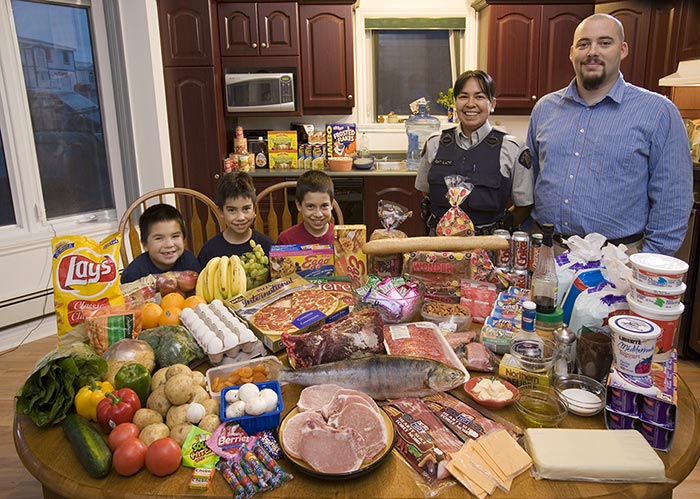
Iqaluit, Canada—The Melanson Family
Shane, 6, Jacob, 9, Joseph, 11, Pauline, 34, and Peter, 30
Expenditure: $392 *
The Melansons’ favourite foods run the gamut from chocolate cereal (Shane) to narwhal and polar bear (Pauline) to donair (Peter). Pauline’s father is an avid hunter and often supplies the family table with fresh meat.
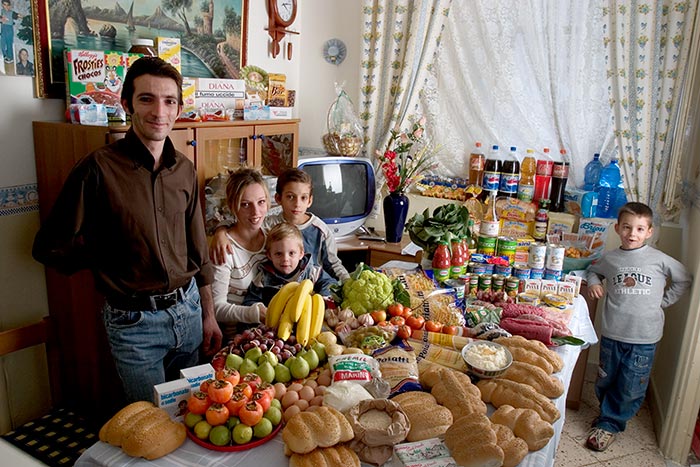
Palermo, Italy—The Manzo Family
Giuseppe, 31, Piera Marretta, 30, Maurizio, 2, Pietro, 9, and Domenico, 7
Expenditure: $295
Giuseppe is a fishmonger, and the Manzos live above the Capo Market in Sicily, where some of the world’s tastiest fresh fish can be found. But Piera Marretta doesn’t like fresh fish, so the seafood of choice in the household is frozen fish sticks. Pietro’s favourite food is hot dogs.
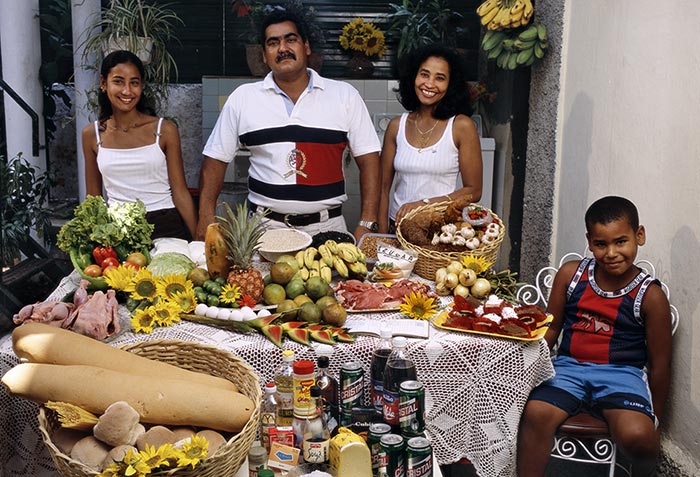
Havana, Cuba—The Costa Family
Lisandra, 16, Ramón Costa Allouis, 39, Sandra Raymond Mundi, 38, and Fabio, 6
Expenditure: $64
In the early 1990s, the Costas, like many Cuban families, raised pigs in their courtyard, but nowadays meat is more readily available in Havana. Government food rations vary according to availability—a pound or two of protein and often coffee, sugar, salt, bread, beans, rice, and oil.
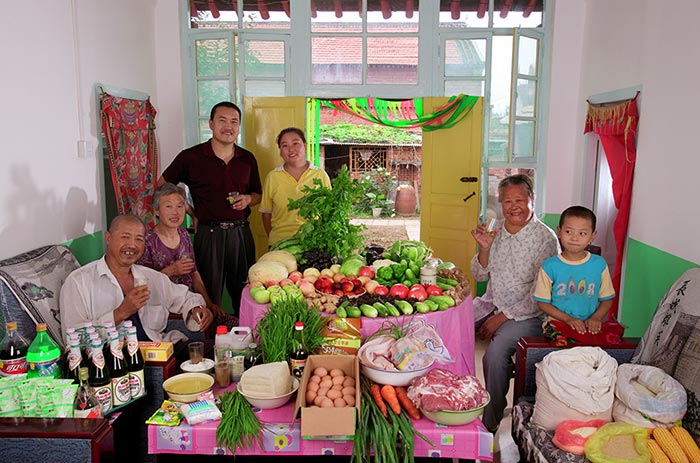
Weitaiwu, China—The Cui Family
Haiwang, 33, Jinxian, 31, and (from left) Haiwang’s father, Lianyou, 59, mother, Xianglian, 61, and grandmother, Wu, 79, and the couple’s son, Yuqi, 6
Expenditure: $65
The Cui family has a small plot of land outside their village, and they also grow tomatoes, cabbage, squash, and cucumbers in their courtyard. Because the government has granted them smaller plots of land in recent years, the family needs to purchase 90 percent of the food they eat.
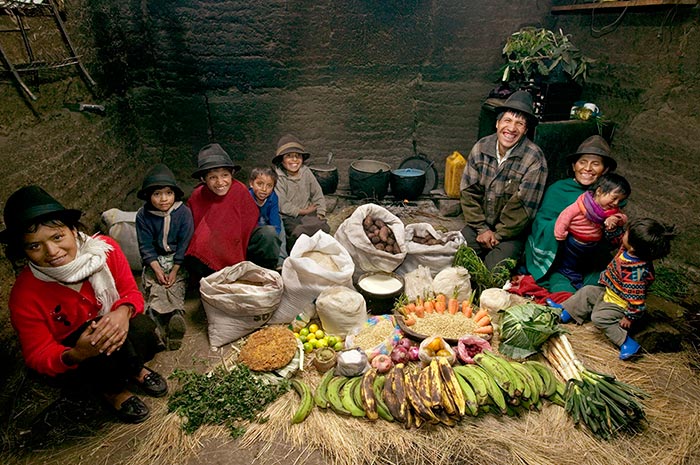
Tingo, Ecuador—The Ayme Family
Orlando, 35, and Ermelinda, 37 (at right), with seven of their eight children (not shown is the couple’s five-year-old daughter, who lives with her grandparents)
Expenditure: $36
The Ayme family lives for most of the year on food that they grow themselves. If they can afford it, on market days Orlando and Ermelinda indulge the family’s sweet tooth by buying some brown cane sugar for everyone to nibble on during the week. Orlando’s favourite food is pea-flour porridge with potatoes.
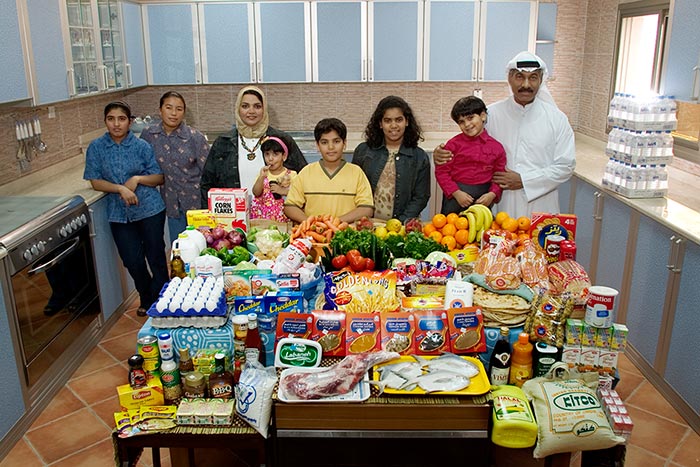
Kuwait City, Kuwait—The Al-Haggan Family
Wafaa Abdul Aziz, 37 (with beige head scarf), Saleh Hamad 42 (at right), the couple’s four children, and the family’s two Nepali servants
Expenditure: $252
A typical breakfast for the family consists of olives, tomatoes, cucumbers, eggs, feta, Kraft and Laughing Cow cheeses, and flatbread. Because of poor soil and lack of water, most food in Kuwait is imported. Forty-nine percent of Kuwaiti women and thirty percent of Kuwaiti men are obese.
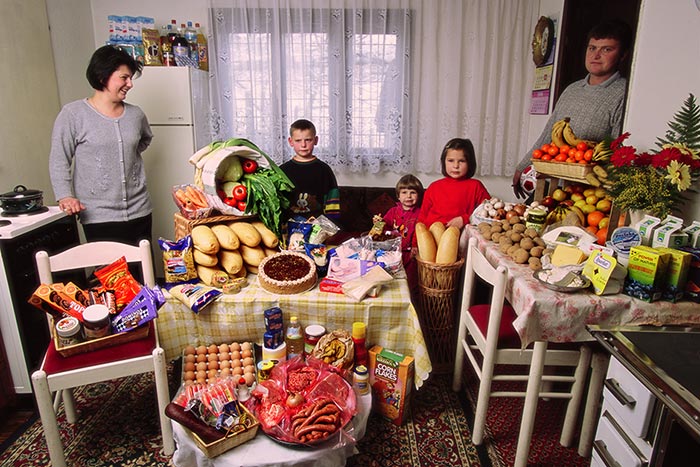
Sarajevo, Bosnia, and Herzegovina—The Dudo Family
Ensada, 32, Ibrahim, 8, Emina, 3, Amila, 6, and Rasim, 36
Expenditure: $90
Despite Ensada’s busy schedule, she does not rely on prepackaged foods. A typical dinner for the Dudos might consist of chicken stew served with ajvar (a preserved eggplant-and-red-pepper spread) on slices of crusty bread. The children love to finish the meal with one of Ensada’s homemade desserts, although they are just as happy with a store-bought Kinder Surprise Egg.
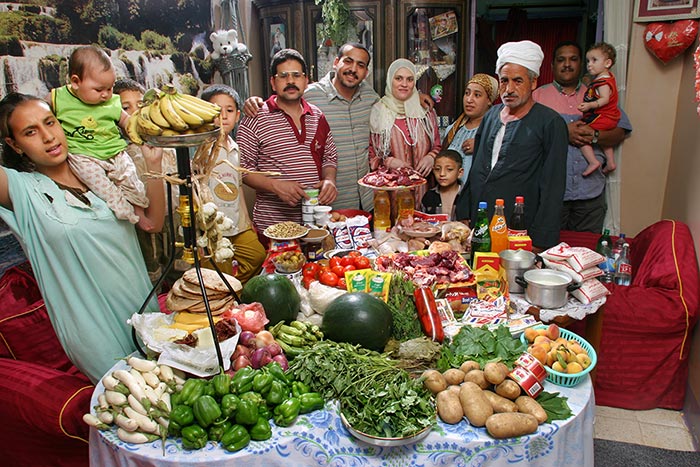
Cairo, Egypt—The Ahmed Family
Mamdouh, 35 (wearing glasses), and Nadia, 36 (with dark-brown head scarf), their three children (far left), six members of Nadia’s extended family, and a family friend
Expenditure: $78
The Ahmed home is often crowded for meals because many members of the extended family live either in or near the Ahmeds’ apartment building. Generally the women in the families cook together. A favourite Ahmed family recipe is Nadia’s tajine, a slow-cooked stew with okra and mutton.
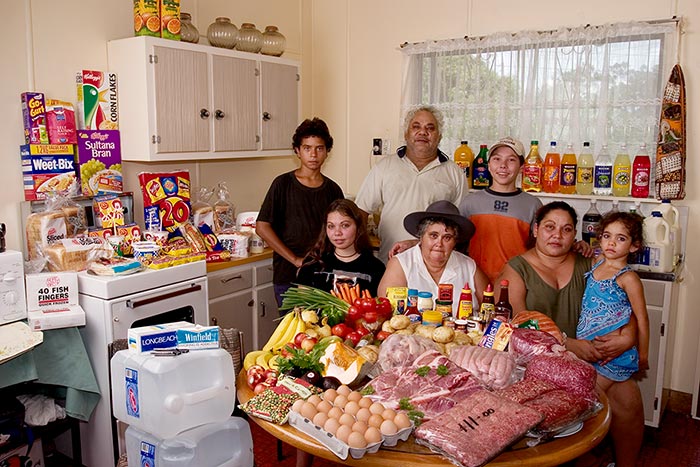
Riverview, Australia—The Brown Family
Doug, 54, Marge, 52, daughter Vanessa, 32, and grandchildren Rhy, 12, Kayla, 15, John, 13, and Sinead, 5
Expenditure: $428
Doug and Marge grew up in the outback, and although they are purposefully unmodern in many respects, this does not extend to Marge’s love of the family’s new refrigerator, nor to Sinead’s preference for “Mackas” (McDonald’s). Morning meals centre around Doug’s fruit salad covered with cream and sugar.
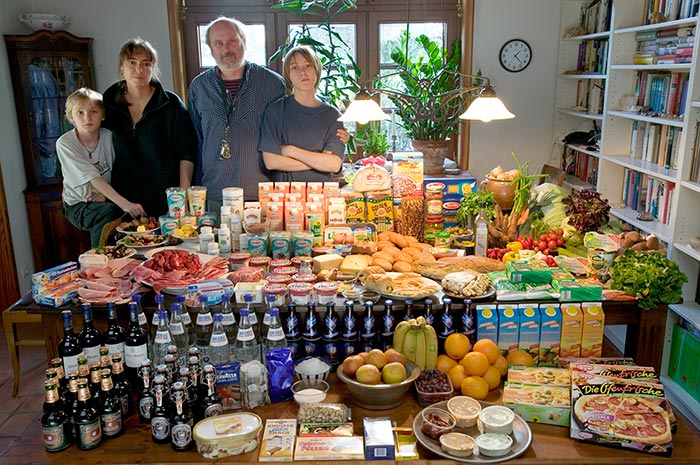
Bargteheide, Germany—The Melander Family
Kjell, 10, Susanne, 43, Jörg, 45, and Finn, 14
Expenditure: $568
Susanne tries to ensure that the Melanders eat nutritious foods and take supplements, though Jörg notes that his favourite dish is fried potatoes with onions, bacon, and herring. Susanne would like to buy only organic food, but it’s simply too expensive.
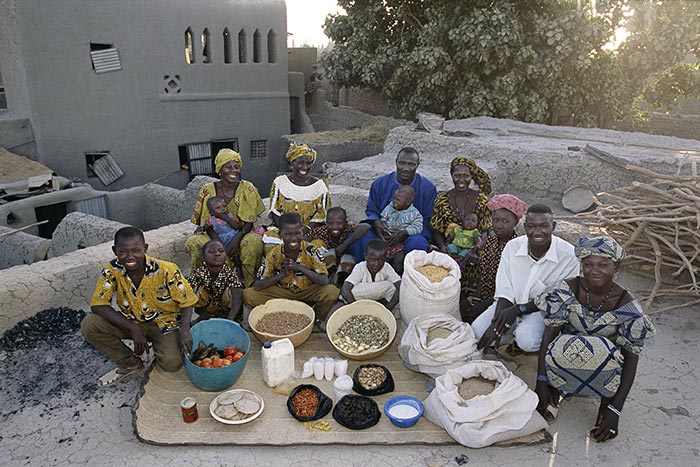
Kouakourou, Mali—The Natomo Family
Soumana, 46 (in blue), with his two wives, Pama, 35 (immediate left), and Fatoumata, 33 (immediate right), their children, and members of the extended family
Expenditures: $30
Asked about their favourite foods, the family says that they don’t think in terms of favourites. All of their meals centre on a millet porridge called tô, which is eaten with various soups and sauces.
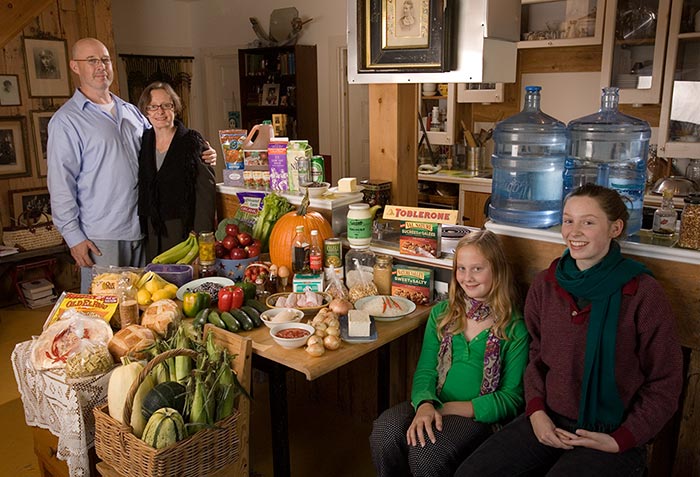
Gatineau, Canada—The Finken Family
Kirk, 43, Danielle, 50, Anna, 11, and Coco Simone, 16
Expenditure: $158
The Finkens try to eat locally produced organic fruit and vegetables and also grow vegetables in their front yard. The children are particularly fond of Indian food—Anna lists her favourite food as matar paneer, and Coco, who recently became a vegetarian, likes spiced lentils and chapatis.
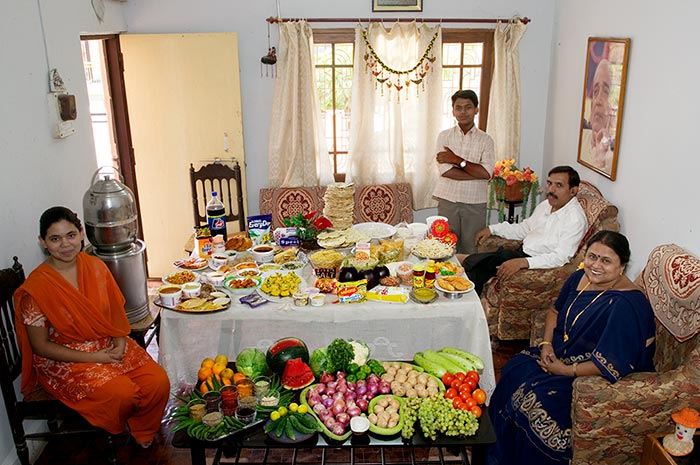
Ujjain, India—The Patkar Family
Neha, 19, Akshay, 15, Jayant, 48, and Sangeeta, 42
Expenditure: $45
Like most devout Hindus, the Patkars are vegetarians. A typical breakfast includes thinly sliced potatoes, onions, and chili peppers fried in vegetable oil and mustard seed, served with rice and chopped cilantro. Sangeeta notes that the Patkars are more flexible about their vegetarianism than her family was when she was growing up. Akshay, for one, says that he has eaten chicken and likes it.
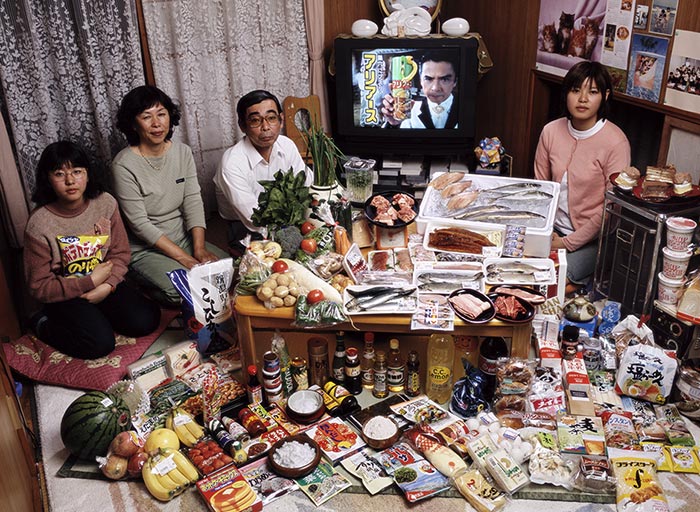
Kodaira City, Japan—The Ukita Family
Maya, 14, Sayo, 51, Kazuo, 53, and Mio, 17
Expenditure: $361
In any given week, the Ukita family will eat at least a dozen types of fish and shellfish and three varieties of seaweed. Like many families in urban Japan, they eat out often. Kazuo’s favourite food is sashimi; Maya’s is potato chips. Only 2 percent of Japanese adults are obese.
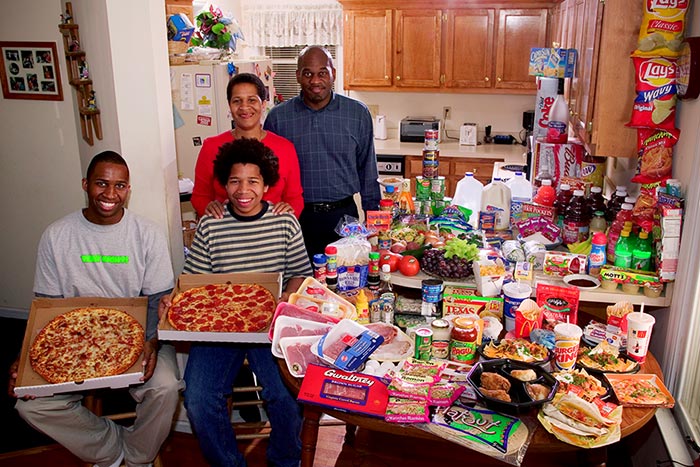
Raleigh, USA—The Revis Family
Brandon, 16, Tyrone, 14, Rosemary, 40, and Ronald, 39
Expenditure: $389
The Revis family has struggled to lose weight at times, and Brandon and Tyrone, Rosemary’s sons from a previous marriage, expressed shock at seeing the amount of food that everyone had consumed in a week. The family has since begun a new exercise program.
[breakline]



